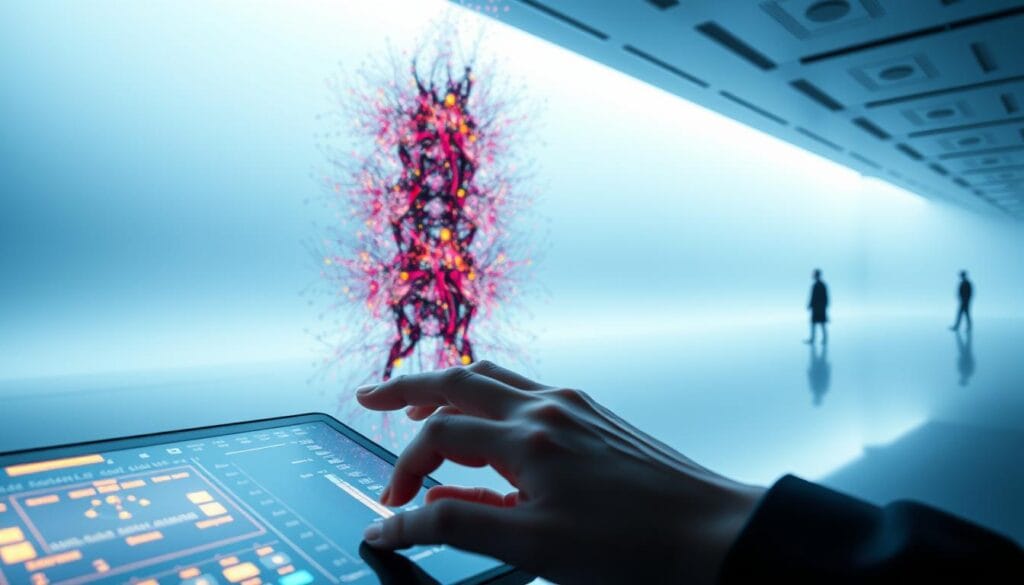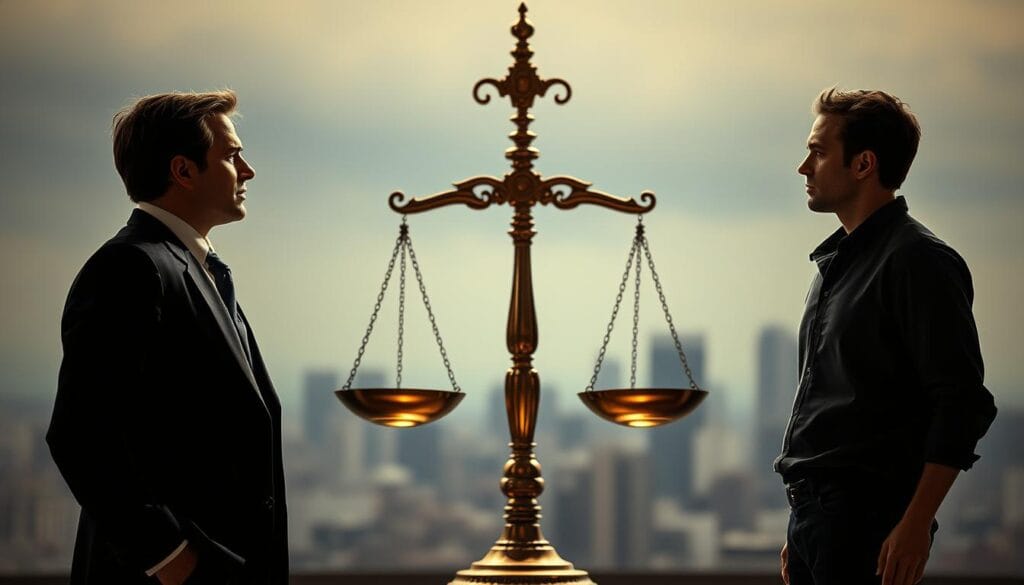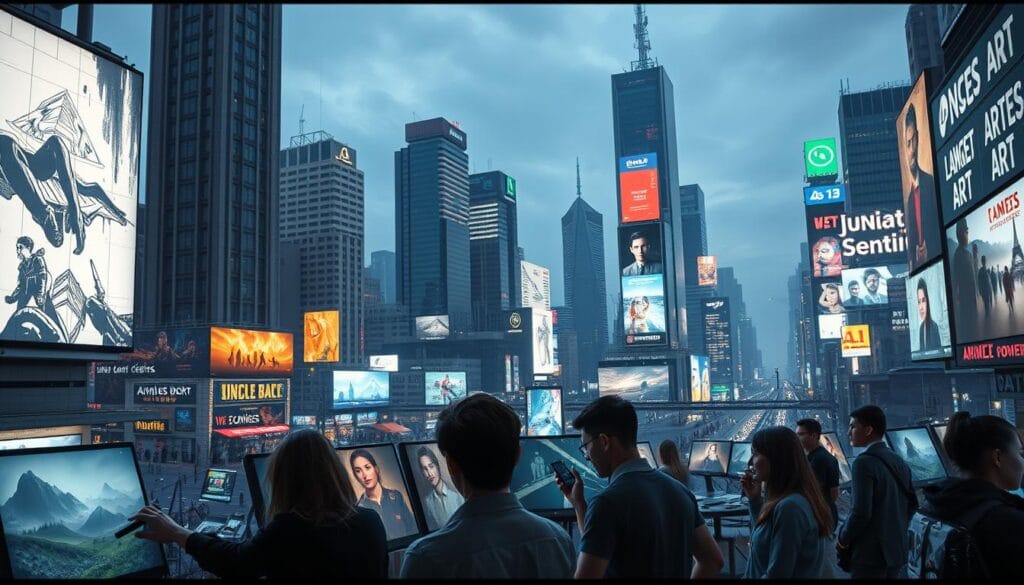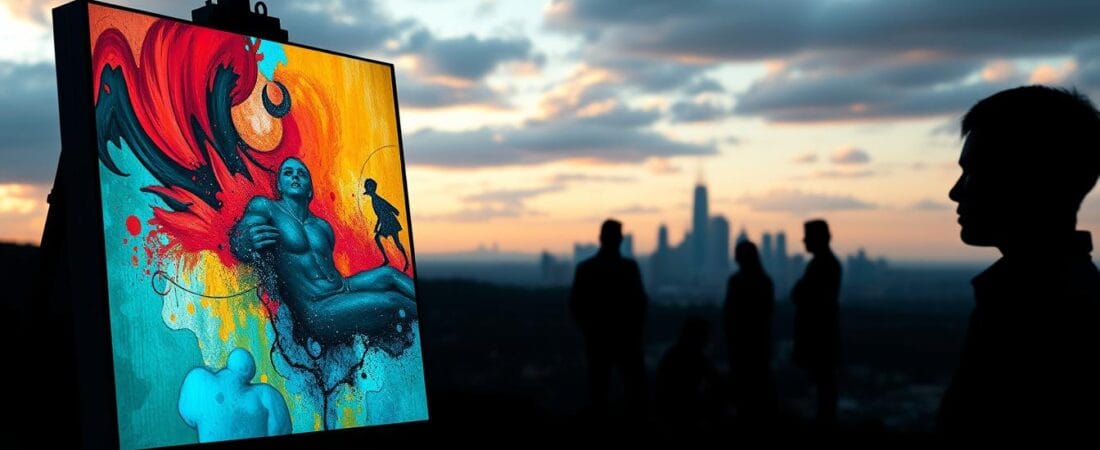Over 15 million AI-generated images flood online marketplaces monthly, yet fewer than 12% of creators fully understand the copyright implications of their digital creations. This explosive growth in synthetic artwork has transformed platforms like Midjourney and DALL-E 2 into modern gold rushes, where art meets algorithm in unprecedented ways.
What began as experimental hobbyists tinkering with neural networks has evolved into a $2.3 billion commercial sector. Artists and entrepreneurs now leverage AI-driven financial tools to monetize these creations, raising critical questions about intellectual property frameworks. Current U.S. copyright law remains ambiguous regarding non-human creators, creating both opportunities and risks.
The heart of the debate centers on ownership rights. Who holds legal claim to artwork produced through text prompts – the user, the platform, or the algorithm itself? Commercial ventures using these images must navigate evolving permission requirements and attribution standards, particularly when modifying existing works through AI filters.
Key Takeaways
- Commercial AI art sales grew 600% year-over-year since 2022
- U.S. Copyright Office currently denies protection for purely AI-generated works
- Platform terms of service dictate commercial usage rights
- Hybrid human-AI creations may qualify for limited copyright
- Proper attribution remains critical for derivative works
Understanding AI-Generated Art and Copyright

Algorithmic systems analyze over 100 million reference images to produce novel visual outputs, creating artworks that challenge traditional definitions of authorship. Unlike human creators, these tools remix patterns from training datasets through layered neural networks, generating outputs in seconds rather than weeks.
What Makes AI Art Unique?
Machine-generated visuals combine elements from disparate sources using probabilistic models, resulting in hybrid compositions no artist might conceive independently. Where painters layer brushstrokes, algorithms stack mathematical transformations – a process yielding unpredictable outcomes even with identical text prompts.
The Role of Copyright in Digital Creations
Current U.S. copyrights law protects only human-authored works, leaving machine-generated outputs in legal limbo. A 2023 Copyright Office ruling clarified that purely algorithmic creations lack protection, though human-curated edits may qualify. This distinction proves critical when determining commercial rights for derivative works.
Platforms often retain licensing authority over outputs, requiring users to review terms before attempting to use ai-generated content commercially. Proper attribution remains essential when incorporating protected elements into new creations, particularly when merging human and machine contributions.
Legal Considerations: Is it illegal to sell AI pictures?

Getty Images’ landmark lawsuit against Stability AI highlights growing tensions in creative industries. The case alleges unauthorized use of 12 million copyrighted photos to train generative models, sparking global debates about permission requirements for training datasets. Legal experts remain divided, with 43% arguing algorithmic outputs constitute transformative use versus 57% claiming derivative infringement.
Overview of Legal Debates
Courts grapple with defining creative ownership when human input involves only text prompts. A 2023 U.S. District Court ruling questioned whether AI-assisted works meet “minimum creativity” thresholds for copyright protection. “The law must evolve to recognize new forms of authorship,” argues Stanford Law Professor Mark Lemley, while traditional creators demand compensation for style replication.
Impact on Artists and Innovators
Digital illustrators report a 22% income drop since generative tools became mainstream, according to Artists’ Guild surveys. Conversely, tech innovators leverage AI business tools to produce customizable designs at unprecedented scale. This dichotomy creates ethical issues – should algorithms trained on living artists‘ portfolios require royalty agreements?
Emerging platforms now implement content credentials to track AI involvement in artworks. However, 68% of commercial buyers remain unaware of potential infringement risks when purchasing algorithmically generated pieces. As legal frameworks catch up, creators must document their creative process meticulously to establish claim validity.
Navigating Copyright Laws and Fair Use in AI Art

The U.S. Copyright Office’s 2023 policy shift marked a turning point for synthetic media creators, redefining how legal protections apply to machine-assisted artworks. Four key principles govern fair use evaluations: purpose, nature, amount, and market effect. These factors determine whether using art generated through artificial intelligence qualifies as transformative or infringing.
Understanding Fair Use Policies
Current guidelines require substantial human modification for copyright office recognition. Works lacking creative input beyond text prompts generally fall outside protected categories. A 2024 ruling emphasized that “output from generative tools alone doesn’t meet authorship thresholds,” according to Copyright Office documentation.
Three strategies help creators create new works legally:
- Combine multiple AI-generated elements with original human edits
- Limit direct replication of protected artistic styles
- Document all creative decisions affecting final output
Educational institutions enjoy broader fair use allowances when using art for research or criticism. Commercial ventures face stricter scrutiny, particularly when algorithms reproduce recognizable elements from existing works. The Copyright Office maintains an online portal for registration attempts involving artificial intelligence-assisted creations.
Legal experts recommend reviewing platform terms before attempting to create new commercial products. As one intellectual property attorney notes: “Proactive documentation separates protected hybrids from unprotected machine output in disputes.”
AI Art Platforms and Licensing Agreements

Digital marketplaces now offer specialized channels for synthetic artwork distribution, each with distinct commercial frameworks. Leading platforms like Etsy and Redbubble host millions of generated images, while dedicated art generators such as Midjourney provide built-in storefronts. These ecosystems require careful navigation of terms service agreements that dictate ownership rights and revenue splits.
Reviewing Terms of Service and Licensing Models
Midjourney’s commercial policy permits usage of outputs for physical products but restricts NFT creation. Adobe Firefly grants broader rights but requires verification that training data sources don’t infringe existing copyrights. Such variations underscore why creators must analyze service agreements line by line before monetizing digital assets.
Three critical factors determine viable platforms for selling synthetic artwork:
- Explicit commercial authorization in generator terms service
- Clear revenue-sharing models for derivative products
- Transparency about third-party claims on generated images
Redbubble’s updated guidelines now flag artworks lacking sufficient human modification, reflecting evolving industry standards. Savvy creators maintain detailed records of prompt engineering and post-processing steps to strengthen ownership claims. As licensing models diversify, consulting a privacy policy expert helps navigate complex usage rights across jurisdictions.
Emerging art generators like NightCafe employ tiered subscriptions where higher plans grant exclusive commercial privileges. This model incentivizes user upgrades while clarifying permissible usage scenarios. However, platform-specific restrictions often require separate legal reviews for each product line developed through algorithmic tools.
Commercial Opportunities and Ethical Challenges in AI Art

The synthetic art market now offers seven-figure licensing deals alongside heated debates about creative integrity. Forward-thinking creators harness algorithmic tools to build scalable businesses while traditional artists question the fairness of machine-assisted works. This collision of innovation and tradition reshapes how society values digital creations.
Exploring Revenue Models in AI Art Sales
Platforms like Adobe Stock now accept AI-generated submissions, enabling creators to monetize outputs through stock photography channels. Successful entrepreneurs combine multiple revenue streams:
– Custom merchandise featuring algorithmically designed patterns
– Limited-edition NFTs with verifiable human curation
– Subscription-based prompt engineering courses
A 2024 Art Basel report showed 38% of digital exhibitors now incorporate machine-generated elements. “These tools let me prototype concepts faster than traditional methods,” notes mixed-media artist Lina Torres, whose works blend hand-drawn sketches with AI enhancements.
Addressing Ethical Dilemmas in Digital Creativity
Critics argue that mass-produced algorithmic creations devalue human craftsmanship. The Artists’ Rights Society recently found 62% of AI-assisted pieces on major platforms contain detectable elements from copyrighted works. Responsible creators implement safeguards:
– Using only ethically sourced training datasets
– Disclosing AI involvement in product listings
– Allocating profits to original artists via tax compliance strategies
Emerging solutions like the Content Authenticity Initiative’s metadata standards help buyers distinguish between purely machine-made and human-guided use ai-generated art. As industry analyst Dr. Ellen Park observes: “Transparency transforms ethical risks into competitive advantages for forward-thinking studios.”
Preventing Infringement and Ensuring Proper Permissions
Legal disputes involving synthetic artwork increased 78% in 2024, with stable diffusion tools at the center of 41% of cases. Proactive creators implement three-layer verification systems to confirm ownership rights before monetizing outputs. “Every digital image carries invisible fingerprints of its creation process,” notes intellectual property attorney Mara Chen.
Verifying Licensing for AI Tools and Outputs
Platforms like Midjourney require users to review art generator terms monthly – a practice that prevented 12,000 potential disputes last quarter. Creators should ask: “Does this style incorporate protected elements?” when developing commercial pieces. Recent rulings against stable diffusion outputs trained on unlicensed portfolios highlight the risks of unchecked use copyrighted materials.
Effective strategies include:
• Auditing training data sources through streamlining compliance processes
• Maintaining version histories of prompt iterations
• Using reverse-image search to detect unintended similarities
Staying Updated with Evolving Legal Regulations
The Copyright Office updates its AI policy guidelines quarterly, with April 2024 revisions clarifying ownership thresholds for hybrid works. Legal analysts recommend subscribing to art generator platform newsletters and court ruling alerts. A recent California case involving stable diffusion outputs established precedent for compensating original artists when algorithms replicate distinctive styles.
Key monitoring resources:
• U.S. Copyright Office AI Policy Tracker
• Artist Rights Alliance infringement reports
• Platform-specific art generator term updates
Monthly audits of creation workflows help maintain ownership clarity while preserving artistic style integrity. As regulations evolve, documenting human creative input becomes the ultimate safeguard against use copyrighted material claims.
Practical Tips for Selling AI Art Online
Digital creators face a fragmented marketplace when monetizing algorithm-assisted works, with platform selection directly impacting revenue potential. Leading marketplaces like Etsy and Redbubble account for 63% of synthetic artwork sales, while niche NFT platforms cater to high-value collectors. Strategic positioning requires matching artistic style to platform demographics and fee structures.
Choosing the Right Marketplace
Wirestock’s 2024 seller survey revealed creators earn 40% more on platforms specializing in digital art versus generalist marketplaces. Key selection criteria include:
- Commission rates under 20% for physical products
- Built-in licensing management tools
- Audience alignment with preferred art styles
Artsi’s transparent royalty system demonstrates how specialized platforms empower creators through AI-driven business strategies. Case studies show stores combining Redbubble’s print-on-demand services with curated NFT drops achieve 73% higher customer retention.
Optimizing Your Digital Presence
Top-performing stores implement three core SEO practices:
- Keyword-rich titles containing medium and style descriptors
- Alt-text optimization for search engine image indexing
- Regular content updates reflecting trending visual themes
High-quality mockups increase conversion rates by 58%, according to Etsy’s 2024 seller data. Detailed descriptions should specify human input percentages and creation tools used. Successful artists like Petra Lin attribute their growth to monthly analytics reviews and adaptive branding strategies.
Conclusion
Navigating synthetic media’s commercial landscape requires equal parts innovation and diligence. Three pillars emerge for creators: copyright awareness, platform compliance, and ethical transparency. Current regulations demand meticulous documentation of human input while marketplaces evolve licensing frameworks for algorithmic outputs.
Successful strategies balance commercial ambition with legal safeguards. Hybrid approaches combining machine-generated elements with original modifications often yield the strongest ownership claims. Platforms like Etsy and specialized NFT marketplaces demonstrate viable paths for monetization when creators prioritize proper attribution and dataset ethics.
The digital art frontier continues shifting as courts refine authorship standards and tools enhance collaboration capabilities. Forward-thinking artists monitor policy updates while establishing clear workflows that document creative decisions. This dual focus on technical mastery and regulatory literacy positions creators to capitalize on emerging opportunities responsibly.
As synthetic media reshapes creative industries, proactive education remains the ultimate competitive advantage. Regular reviews of platform terms, copyright rulings, and ethical guidelines empower artists to navigate this dynamic space confidently. The future promises expanded commercial potential for those who harmonize algorithmic efficiency with human ingenuity.

